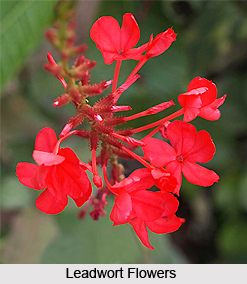Leadwort is a bushy, perpetual herb with bitter roots. It grows thickly upto 2 metres in height with 10 to 20 stems developing straignht from the root. The plant has polished leaves and diminutive, shiny red flowers.
 The herb contains an orange yellow pigment, plumbagin, a sitosterol and a fatty alcohol. The ratio of plumbagin differs within the limits, according to the locality, growth, age, condition of the soil and season. The older the plant and drier the soil, greater is the magnitude of vigorous principle found in its roots.
The herb contains an orange yellow pigment, plumbagin, a sitosterol and a fatty alcohol. The ratio of plumbagin differs within the limits, according to the locality, growth, age, condition of the soil and season. The older the plant and drier the soil, greater is the magnitude of vigorous principle found in its roots.
Methods of usage
Leadwort comes to immense household use in instances of boosting exuberant perspiration and salivation, intestinal disorders, skin eruptions, rheumatism.
Healing Power and Medicinal Properties of leadwort
The root of the plant is acerbic and acts a stimulant. It is helpful in causing profuse perspiration and in furthering salivation. It also fortifies the stomach and assists in its action. The leaves are nearly insipid, with hard cellulose and are somewhat viscous. Approximately 60 ml of raw juice of its leaves can be consumed on its own or may be added to mixed green vegetables and lettuces to make porridge or cake.
Intestinal Disorders cured by leadwort
Its leaves are functional in instances of dyspepsia diarrhoea and piles. It amplifies digestive powers and arouses appetite.
Skin Disorders cured by leadwort
Due to its skin agitating attribute, the herb is used in the treatment of chronic skin diseases, as well as in leukoderma and baldness. A paste made with salt and water is useful for persistent skin diseases such as syphilitic ulcers, scabies, varicose ulcers and ringworm. Paste of the root is also used over glandular tumours and abscesses. The juice of its root, even more efficient if fresh, is extremely caustic and scalds the skin.
Rheumatism healed by leadwort
The herb is useful for treating rheumatic and paralytic malfunctions. If coalesced with a little flavourless oil such as refined coconut oil, it is massaged externally over the affected parts.
Precautions
The root in enormous doses is a sedative and irritant. It should hence be prescribed only in small dosages of 0.75 to 1.25 grams.



















